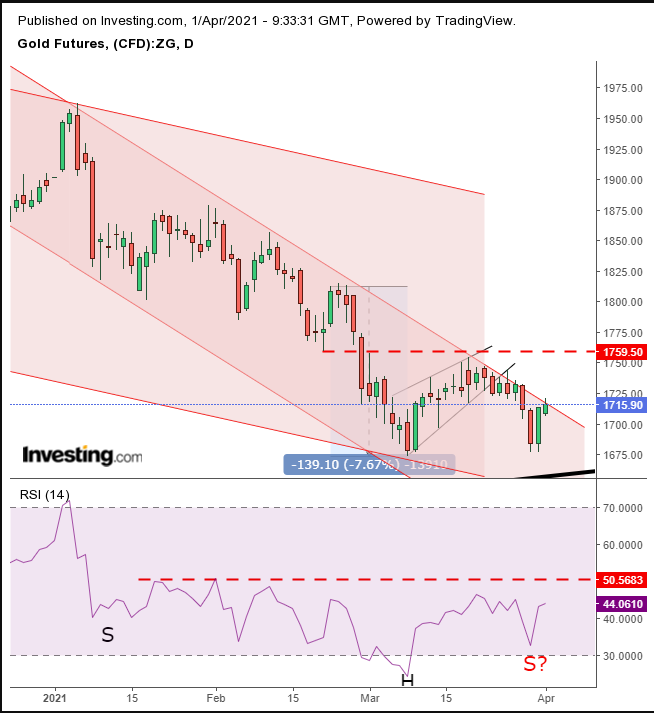The outlook for gold is not promising. Expectations for higher interests rates makes the yellow metal less attractive.
The Fundamentals
Rising yields come about with expectations for rising rates, amid the economic recovery and rising inflation. Given that gold does not produce a yield—unlike the dollar via interest rates—rising rates favor the USD, at the expense of gold. Also, a rising greenback makes the yellow metal, which is priced in dollars, more expensive, hitting demand, which hurts gold even more so.
After hitting a new all-time high last year, gold has fallen back to its pre-coronavirus levels which is telling. Investors think the virus and lockdowns are behind them. They expect that COVID-19 vaccines will allow the economy to reopen and pick-up where it left off before the coronavirus outbreak, boosted by unprecedented infrastructure spending.
The Technicals
Gold has completed a rising flag—a price move which speculators believe shows a rebound is underway, but which turns out to be a short-lived short-cover bounce before another leg down.

The flag fits precisely within a falling channel since the January high—mirroring the dollar bottom—and the flag’s conclusion signals the new, steeper channel will break through the bottom of the more tempered, broader falling channel since the August record.
Caution
With a resurgence of the coronavirus, renewed lockdowns and extended social restrictions around the world, and with challenges to President Joseph Biden’s ambitious infrastructure plan, the fickle market can flip the risk switch.
From a technical perspective the price may find support by the bottom of the original falling channel, which in turn may find support by an uptrend line since the May 2019 low (seen in the thick, black line peeking from the bottom of the chart).
Finally, note, the RSI may be producing a H&S bottom for momentum.
A climb back over the $1,760 level will complete a double bottom that catapults the price back toward the top of the broader channel, as it breaks through the sharper channel.
Therefore, proceed with caution. In trading, nothing is ever in the bag. Employ money management, such as the following:
Trading Strategies
Conservative traders should wait for the price to break through the long-term (thick, black) uptrend line since the May 2019 bottom, then for a return-move that finds resistance, before committing to a short position.
Moderate traders would short after the same crossing below the long-term uptrend line, and for better entry for a rebound, if not for confirmation.
Aggressive traders could short at will, having accepted the higher risk that goes with moving ahead of the rest of the market, for a better seat. Risk management is essential. Here’s an example:
Trade Sample
- Entry: $1,720
- SL: $1,760
- Risk: $40
- Target: $1,600
- Reward: $120
- Risk-Reward Ratio: 1:3
Author's Note: This is just a sample. If you haven’t read and understood the actual analysis and inherent risks, do NOT trade. Even if our analysis is correct—and it may not be—if you read the article you’d know the market can flip, as we described, or in any other unforeseen way. Even if the analysis is correct, the sample may not be. Even if the sample is correct, it may not work for you, based on your personal budget, timing and temperament. If it isn’t clear by now, trading is a complex undertaking, and if you’re looking for fast, easy money, trading is not the answer. All we can offer you is this: take small risks, until you gain the experience to know how to customize your trading plan and gain the wisdom to understand that—like anything else—trading requires patience, skill and experience to hope to make consistent returns. If you approach these traders with the will to learn, you may make money someday. If you are here for the big buck and fast, you never will.
